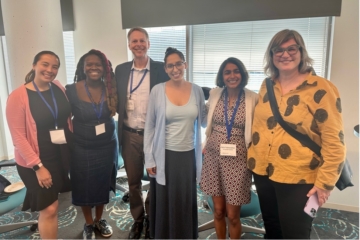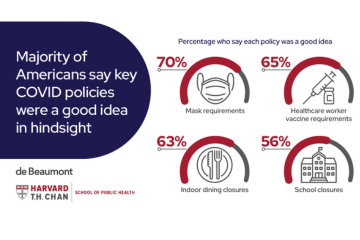
There was no “one-size-fits-all” approach to protect people experiencing homelessness from COVID-19. In all aspects of their pandemic responses, local governments faced diverse and significant challenges. Urban health departments were well positioned to bring together community partners across their jurisdictions, collect and use hyper-local data to identify needs, and implement innovative policies and programs to protect people experiencing homelessness.
As they worked to prevent outbreaks, the United States’ largest cities directed significant resources toward preventing the spread of COVID-19 among individuals experiencing homelessness. Urban public health departments faced varied challenges depending on the demographics of each jurisdiction. They also experienced different constraints, whether monetary, political, or otherwise. That said, these public health professionals shared a mandate to protect the health and well-being of residents in their jurisdictions. To better understand the strategies used by Big Cities Health Coalition (BCHC) member jurisdictions to support and protect residents experiencing homelessness during the COVID-19 crisis, BCHC staff contacted and interviewed a select group of health department staff. The BCHC is a forum for the leaders of America’s 30 largest metropolitan health departments to exchange strategies and jointly address issues to promote and protect the health and safety of the more than 60 million Americans they serve.
Three informational interviews were held, and additional information was gathered from 12 other jurisdictions by reviewing e-mail correspondence, publicly available documents, and Web resources. The jurisdictions examined were Alameda County, Austin, Chicago, Columbus, Detroit, Los Angeles County, Mecklenburg County, Miami-Dade County, Multnomah County, New York City (NYC), Philadelphia, San Diego County, San Francisco, Seattle-King County, and Washington, District of Columbia. These jurisdictions were chosen because they represented geographically diverse areas and provided readily available public records on their COVID-19 response. We acknowledge the limitation of only highlighting these jurisdictions and some of their strategies and are aware that there are jurisdictions that implemented other policies and practices not discussed in this article. Ethical approval was not needed for this project.
On the basis of the information gathered from these 15 BCHC health departments, the strategies to protect residents experiencing homelessness most frequently implemented included expanding housing through collaborations with community-based partners, increasing on-the-ground outreach and resource allocation to people experiencing homelessness, and developing integrated communications. Despite the diverging challenges posed by the pandemic, these actions sought to limit outbreaks among residents experiencing homelessness and promote the health of individuals at increased risk of severe illness.
Supporting Shelters and Community Partners
From the beginning of the coronavirus outbreak in the United States, it was clear that urban public health departments needed to collaborate with shelters and homeless service providers to protect people experiencing homelessness. Many important policy levers, such as “stay-at-home” orders and “social distancing,” proved challenging to implement in shelters or encampments.
In response, local jurisdictions created unique solutions to provide additional housing for people experiencing homelessness, allowing for distancing among healthy individuals and isolation and quarantine for individuals who have tested positive for COVID-19.
Expanding housing
Many cities looked to deconcentrate shelters by reducing density. These efforts were often accomplished through relocating individuals in large, crowded shelters to newly created facilities. San Diego, California, created a socially distanced shelter at its convention center, with a capacity of 1300 beds. Seattle-King County, Washington, took a similar approach, setting up 7 new alternative shelter locations to house 750 individuals, which allowed for increased distancing and sanitization at existing shelters. Multnomah County, Oregon, added shelter space in public buildings such as community centers and convention centers, in addition to keeping winter facilities open. The District of Columbia used hotels to provide overflow emergency shelter for families. Chicago, Illinois, opened 5 emergency shelter facilities and expanded shelter bed capacity by around 700 beds to serve families, youth, women, and men.
As cities across the United States experienced increased COVID-19 community spread, urban public health departments saw a need to provide safe housing for those who tested positive or had contact with someone who tested positive. Cities used hotels, recreational vehicles, and other venues to offer free housing to anyone who could not isolate or quarantine in his or her current living situation. These sites typically provided meals and were staffed by medical professionals. While many city-run sites for isolation and quarantine were not exclusively for individuals experiencing homelessness, health department staff in Austin, Seattle, and other sites anecdotally reported that well over 50% of occupants identified as homeless.
Seattle-King County set up 4 isolation/quarantine facilities for up to 300 individuals, as well as 3 assessment and recovery centers for up to 1200 individuals. Columbus, Ohio, working with partners, opened a new site explicitly for residents experiencing homelessness who either tested positive for COVID-19 or were suffering from symptoms of COVID-19. The site was staffed by Medical Reserve Corps and other medical and public health professionals. Miami-Dade County, Florida, added 400 additional hotel rooms available for residents needing to isolate with or without symptoms. Miami-Dade also created a new “help line” to expand access to isolation rooms.
Many cities took an additional step beyond isolation and quarantine housing by providing “protective” housing, or private rooms, for high-risk individuals. Austin set up 4 “protective lodging sites” to house more than 300 individuals experiencing homelessness who met the Centers for Disease Control and Prevention (CDC) high-risk criteria free of cost. Chicago, along with a federally qualified health center partner, moved people at increased risk from congregate shelters to private rooms. Similarly, Philadelphia’s “COVID-19 Prevention Spaces” were provided via referral to high-risk individuals currently housed in congregate housing. In Los Angeles County, California, Project Roomkey was developed to provide hotel and motel rooms to high-risk individuals experiencing homelessness through a community or health care referral. Project Roomkey hotels were staffed by state, county, and city employees across multiple sectors, including fire, disaster services, and clinical, security, and homeless service providers.
Supporting existing shelters
Existing homeless shelters also faced immense logistical stress due to the COVID-19 pandemic. In addition to creating new shelters, health departments worked with these existing shelters and homeless service providers to reduce the spread of the virus; some cities developed specialized task forces to provide support.
Seattle-King County created 2 specialized teams to support its pandemic response. A Homeless Task Force “Strike Team” was established to respond quickly to suspected outbreaks in shelters by assessing the level of contagion, conducting testing, talking with individuals exhibiting symptoms, and referring people to isolation or quarantine or recovery sites. The Homeless Health Field Assessment, Support and Technical Assistance (FAST) team provided preventive support by offering on-site assessment, support, and technical assistance to homeless and supportive housing programs. The FAST team developed simple and clear standards for shelters, conducted assessments, and supported implementation of recommendations.
Similarly, the NYC Department of Health and Mental Hygiene developed a Congregate Settings Investigation and Response Unit to work in partnership with the NYC Department of Homeless Services and homeless service providers. This unit worked to quickly identify positive cases among residents and staff, coordinate with shelter management, conduct case investigation interviews, and support implementation of isolation and quarantine recommendations. Some recommendations this unit made included rearranging beds, reorganizing commons rooms so that chairs are at least 6-ft apart, implementing and enforcing stricter room capacity limits, extending and staggering mealtimes, and limiting gatherings. District of Columbia performed similar modifications in shelters. It also implemented shelter assignments so that clients slept in the same bed in the same shelter each night.
Other cities offered regular opportunities to supply technical assistance and continue engagement between homeless service providers and the health department to ensure that people could be safely housed during the pandemic. The Chicago Department of Public Health provided weekly webinars to train staff at homeless shelters and provided resources to ensure shelters were practicing precautions necessary for infection prevention and control. Philadelphia, Pennsylvania; Seattle-King County, Washington; and Alameda County (Oakland), California; all conducted weekly calls with homeless service providers to address the unique operational challenges needed to safely shelter people during the pandemic, with calls addressing coordination, questions, and updates.
Increasing behavioral health support
In addition to needing housing, many people experiencing homelessness were in need of access to a spectrum of support.
Many jurisdictions provided mental health counseling, addiction treatment options, and linkage to wraparound services for individuals staying in their quarantine, isolation, and protective housing facilities. District of Columbia’s isolation and quarantine sites provided case management for the duration of each individual’s stay and additional behavioral health support as needed. NYC conducted methadone delivery to isolation sites, including a naloxone kit. Chicago, with its federally qualified health center partner, provided supportive wraparound services for individuals staying in their high-risk protective housing. Los Angeles’ Project Roomkey, which provided hotel rooms to high-risk individuals experiencing homelessness through referral, helped each client develop a plan to transition to a sustainable housing solution, in collaboration with the on-site providers, housing authority, the county, and nonprofit partners. Ultimately, the program’s goal was to move all clients to a situation that permanently resolves their homelessness.
On-the-Ground Outreach
The crisis created by COVID-19 made it much harder for people experiencing homelessness to meet vital basic needs such as eating, using a restroom, or washing their hands. Public health departments responded to this increased need and provided new COVID-19 mitigation measures for people experiencing homelessness.
Supporting unsheltered populations
Importantly, additional services were also provided to people experiencing homelessness who either choose to stay unsheltered or were unable to find housing in a shelter. The CDC recommends that cities allow people who are living unsheltered or in encampments to remain where they choose. Clearing encampments can cause people to disperse throughout the community and lose connections with service providers, increasing the potential for disease spread.
To reduce the spread of coronavirus, Austin Public Health worked diligently to educate other city agencies about the risks of clearing encampments and ensure that those living in encampments had appropriate information and supplies.
NYC increased outreach efforts at high-priority, end-of-the-line subway stations where many individuals living unsheltered sought refuge. Outreach workers connected people to needed services and housing options, with the goal of reaching more unsheltered New Yorkers at the peak of the outbreak. San Francisco, with the highest rate of residents experiencing unsheltered homelessness, understood the unique challenges they faced and creative problem solving required. Accordingly, San Francisco piloted “Safe Sleeping Villages,” developing safe and healthy outdoor spaces for people who are unsheltered. These sites provided a safe and healthy area to stay and access services such as food, water, sanitation, and health care. People experiencing homelessness at “Safe Sleeping Villages” were provided regular COVID-19 screening and temporary isolation when awaiting transfer off-site. Each “village” served an area with an existing encampment. This pilot implementation and ramp-up required a great deal of coordination between the health department, the mayor’s office, emergency operations center, board of supervisors, board of education, parks and recreation, homeless service providers, the business community, and residents themselves.
COVID-19 testing
After an initial focus on “drive-through testing,” jurisdictions realized the importance of testing those without cars, who often are lower income and may be experiencing unstable housing and/or homelessness. Mecklenburg County, North Carolina, provided transportation for those experiencing homelessness in need of testing. Austin worked with a local medical school, health centers, and shelter-based clinics to expand efforts to provide appropriate outreach, health care, and testing for individuals experiencing homelessness.
Mobile testing sites, though costly, allowed for data-driven adjustments and increased access in areas of high need near encampments. In San Francisco, the city collaborated with trusted community organizations to help raise awareness about mobile sites and connect people to services as needed. San Diego and Chicago deployed Public Health Nurses with Homeless Outreach Teams to screen people living unsheltered to determine whether they were symptomatic and required further evaluation.
In addition, understanding the risk of a rapidly spreading outbreak in settings of congregate living such as shelters, some cities worked with shelters to test staff and clients. When there was at least one known COVID-positive staff or client at a homeless shelter, the Chicago Department of Public Health, in partnership with local medical centers, conducted widespread testing of the shelter’s staff and clients. Following positive tests among staff members, Austin used at-home and mobile testing for shelter staff, which allowed for rapid prevention of spread so that shelters could stay open.
Masking and hygiene
Knowing the preventive impact of simple measures such as hand washing and masking, urban health departments concentrated on increasing access to face coverings, hand sanitizer, and hand-washing stations, particularly among those for whom social distancing and staying at home are difficult or impossible. Mecklenburg County worked with a hospital system to share a large shipment of masks with local homeless service providers. Many areas collaborated with shelters to implement and enforce universal masking policies for all staff members and clients. Chicago collaborated with medical student volunteers to distribute thousands of masks to shelter residents and staff. NYC also distributed masks to shelters for staff and clients. Seattle-King County and NYC regularly gave out face coverings free of charge to the most-impacted communities across each respective jurisdiction.
In addition to providing masks, cities ensured widespread access to other tools necessary to prevent the spread of COVID-19, recognizing gaps created when public toilets closed at the start of the pandemic. Cities widely distributed hand sanitizer, hand-washing stations, and other materials to prevent the spread of COVID-19. Chicago’s Homeless Outreach Program conducted outreach to assess the need for resources, identify high-risk residents, and provide linkage to services. They then deployed mobile restrooms and hand-washing stations to the city’s larger encampments and distributed masks, hygiene kits, hand sanitizer, and wipes.
San Francisco deployed new portable toilets and hand-washing stations at 15 high-need locations, available for use 24 hours a day. Philadelphia established 8 hand-washing stations and deployed 3 mobile bathroom facilities to locations determined by recent data to maximize effectiveness. Mecklenburg County deployed hand-washing stations to be operated by a homeless service partner. Similarly, Austin supported mobile hand-washing stations, portable toilets, and shower trailers through partnerships with local nonprofit organizations. Austin Public Health also identified brick-and-mortar showers and toilets available to residents experiencing homelessness in closed city buildings and other locations.
Food access
The pandemic also limited food access for people experiencing homelessness across the country. Economic shutdowns led to fewer donations, exacerbated food insecurity, and logistical challenges for food banks.
Austin Public Health partnered with various partners to create the Eating Apart Together (EAT) Initiative. This program centralized distribution of bags with a week of shelf-stable food, as well as masks, hand sanitizer, toilet paper, and educational flyers about preventing the spread. Some bags were taken directly to known encampments, and some were handed out at existing meal delivery programs. The EAT Initiative also distributed packaged ready-to-eat meals to existing service locations for pick up by residents experiencing food insecurity.
Philadelphia partnered with nonprofit organizations to create the Step Up to the Plate Program, a meal and food deployment plan using new emergency outdoor meal sites that also offer medical and/or other programming in areas where there are many people living unsheltered. The Step Up to the Plate Program offered more than 10 000 meals weekly while adhering to social distancing guidelines.
Early in the pandemic when restaurants closed for dine-in service, Detroit, Michigan, started partnering with a local nonprofit organization and area restaurants to repurpose surplus food that might otherwise have gone to waste and provide that food to residents in need. The inventive program is a notable win-win, supporting residents with food insecurity while providing businesses with tax credit.
Communication and Education
During a pandemic, people look to public health departments and other governmental officials for guidance to direct behavior.
As such, communication and education were critical tools for public health departments, which allowed them to disseminate messages to broad audiences throughout the pandemic response. For many cities, this means distributing clear flyers, in several languages with digestible graphics. Multnomah County (Portland), Oregon, collaborated with Portland Street Medicine and existing homeless outreach providers to create and distribute laminated cards that discuss how to care for a sick person and when to seek medical care. Chicago’s Homeless Outreach Team developed and distributed educational material on COVID-19, social distancing, hand washing, covering coughs, and more. Austin’s EAT Initiative food bags featured graphic-focused flyers with information on how to stay safe, access service, and meet needs. The city also spread information through posters on popular bus routes and advertisements in the local newspaper created by and for Austinites experiencing homelessness. Austin also created physical street signs indicating “basic needs sites” (locations with hand-washing stations, food distribution sites, charging stations, toilets, and showers).
While flyers are certainly important, many individuals experiencing insecure housing or homelessness do have access to the Internet. As such, city Web sites were updated to include the latest information on where to access services. Multnomah County and San Francisco added additional details to their Web sites about how to stay safe and healthy while living unsheltered. San Francisco, Seattle-King County, and Alameda County also included interactive maps on their Web sites to help people find necessary services. Austin Public Health’s Homeless Service Division repurposed the city’s homelessness Web site to provide COVID-19–specific information, including a “basic needs map.”
Discussion and Conclusions
All municipalities focused on reducing spread of COVID-19 among people experiencing homelessness by increasing safe housing options, providing on-the-ground outreach and resources, and promoting clear, informative communications. On the basis of local needs, however, different approaches were employed to address local issues, leading to a diverse set of approaches from public health departments. Local health departments, working closely with city human service agencies and homeless service providers, can identify the unique needs of their city’s residents experiencing homelessness or at risk of becoming homeless and adapt these strategies appropriately. In addition, while some of these strategies were evidence-based, many were evidence-informed and/or promising practices, indicating that research to determine effectiveness will be beneficial for the field and future pandemic planning.
There is always more that can be done by partners across the spectrum from local, state, and federal levels of government to community members and research institutions in order to support those experiencing homelessness. However, in order to truly support these individuals, governmental public health, and local communities at large need additional funding and reimbursement mechanisms. All the actions taken by urban public health departments to mitigate spread required both labor and financial resources.
The field must continue to develop existing partnerships and build new ones, emphasizing breaking down the old siloes in which human services, public health, and health care operated separately. No single-city agency or community-based organization can do this alone. As big city health departments continue to use data to drive decision making, ensuring that data are publicly available and processes are transparent is paramount.
At the beginning of the pandemic in early 2020, jurisdictions mostly focused on those individuals already experiencing homelessness—a known entity. As our economy struggles to rebound, unemployment benefits decrease, and eviction moratoriums expire, even more individuals could be at risk of losing housing or becoming unstably housed. It is likely that cities will start to see a whole different picture of homelessness than prior to the pandemic. Another impact of the economic downturn is financial difficulties among social service agencies and nonprofit organizations, which can lead to reduction in services even while the number of people in need of those services has increased. The strategies highlighted in this article were driven by immediate need in a public health emergency, but it is clear that there is a need for policies and longer-term interventions to address underlying disparities and social needs. Fortunately, urban health departments recognize their role in ensuring the health and safety of all residents and are already working to mitigate the impact of COVID-19 and other compounding factors, such as hunger, stress, and other chronic conditions. Much is being done to protect people experiencing homelessness, but there is still so much more to do.
This column first appeared with the title “Supporting and Protecting Residents Experiencing Homelessness in the Nation’s Largest Cities During COVID-19” in the January/February 2021 issue of the Journal of Public Health Management & Practice. See the final authenticated version.




